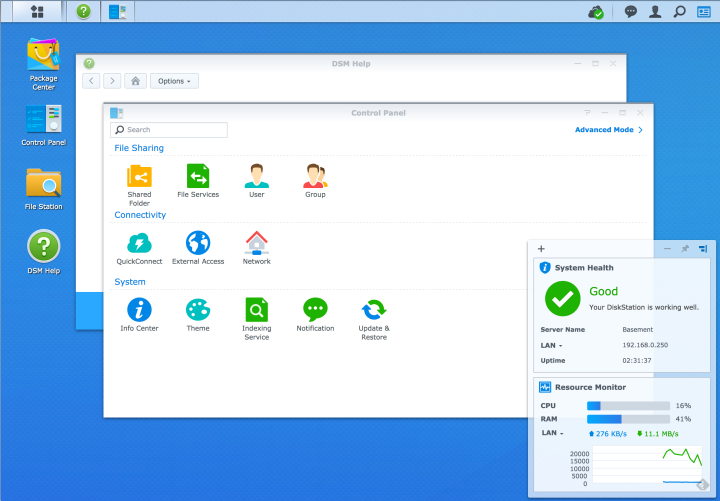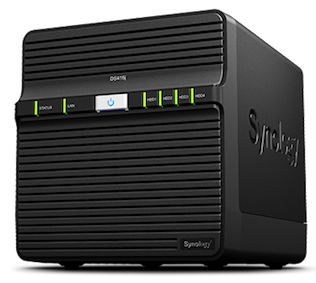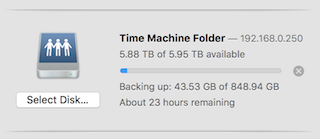
A couple days ago in New Home Network I posted a request for advice on a home NAS box and networking hardware. Now I have the storage box, and boy was it ever easy and straightforward and anxiety-relieving. If you haven’t done this already, you might want to.
What’s a NAS? · It’s a box, usually with no screen and no controls, a power plug, and a network connection. You hook it up to your home network with a cable (not WiFi) and it looks like another disk on all the computers in your house.
Except for, it’s usually a lot bigger and more reliable disk than any single computer would have. It’s like your home has a built-in disk drive.
The online reviews favor QNAP and Synology; the comments on my blog suggested Synology or build-your-own-it’s-fun. I have opinions about “fun” and about “storage for my irreplaceable digital life” and they don’t intersect. So I bought a Synology DS416j and two Western Digital “Red” 6T drives from fave local retailer NCIX — if you’re in Canada, you can’t beat ’em.

(Yes, I only half-filled the enclosure. I splashed out because I smell bigger cameras and the possibility of video in the future, and dropping in two more drives at some future point is going to be easier than shifting boxes.)
It’s easy to set up if you’re not scared of a screwdriver, and comes with Ikea-style cartoon instructions.
Once you have it plugged into your network it’s easy for a browser to find, and the configuration isn’t challenging. It doesn’t want you to bother your pretty little head about filesystem types or RAID configurations, just mirrors the two drives. Various pieces of software disagree how much space you have; on my Mac, Time Machine says 5.95 TB, but df says 5.47. But what’s 500 gigabytes between friends?
There’s no reason to have it accessible, but also none to hide it away, it’s not very big and nicely quiet even when working hard.
Gripes ·
It takes 4 screws for each 3.5" drive and they only shipped 8. If I’d had 4 drives I would have had to track down more.
To actually mount it on your Mac first time, you have to know its IP address (which to be fair the web admin app shoves in your face), and then go to the Finder, type Command-K, and then a URL-like-thingie beginning
afp://. I wonder how many old farts’ eyes will roll the way mine did?The Synology Web client is annoyingly cheerful and smells like Windows 3.1.
What I did · Well, I have all sorts of ambitions about Plex and iTunes and so on and so forth, but the real reason I bought this is that I have a lot of pictures and music and so on spinning on old disks with a backup strategy that involves a combination of Time Machine on an old Airport, and manual rsync between two computers. Yes, you are all allowed to sneer at me, and I was having a background rumble of uneasiness.
So, I did these things:
Set up the Synology as a Time Machine disk.
Arranged for it to back up everything to Amazon S3, encrypted by the NAS before sending.
Arranged for S3 to shuffle it off to Glacier after 30 days.

Which involves multiple steps and, in the S3 case, making credentials and cut-n-pasting; probably out of the reach of civilians.
Which is a real pity. Because, while I try not to promote my employer excessively in this space, I know a lot about S3 and am pretty convinced that it’s is about the safest place in the known universe to store information you really care about.
Seeing that Time Machine readout makes me happy. Yes, that’s kind of slow, but at least one other loved one is simultaneously dumping a MacBook-full of data in.
Security · It’s a mixed bag. I must have fat-fingered the account name on initial setup because it wouldn’t let me log in and I thought I’d bricked the thing. Turns out that if you have physical access to the Synology, and a paper clip, you can reset all the passwords. Which, at the time, I appreciated. But…
Then there’s this thing called QuickConnect: “Access your Synology NAS over the Internet and share files”, they say. Eek! I think that sharing my files across the Internet is exactly what I don’t want my basement storage appliance to do.
Uh safe? Read the explanation and make up your own mind. I turned it off.
What the world needs · Is something like this, only easy, so you turn it on and hit the “Next” button four times, and you have it all set up like I do, with Time Machine and S3 and Glacier. So ordinary smart people who aren’t Internet geeks can have safer data.

Comment feed for ongoing:
From: John Cowan (Dec 21 2016, at 07:32)
It's really using Appletalk? Wow. On the third day it rose again from the dead ....
I think it's worth pointing out that Glacier is now practical for backup, because you aren't beggared by trying to restore a whole disk at once, as was the case until November. Until then, you could store a terabyte for $7 a month, but retrieving it in 4 hours would cost you $1840. Now for standard (3-5 hour) retrieval you pay a penny a gig, or $10.24, which is perfectly fine. (Add to that standard S3 costs if you need to get it out of the cloud.) Before, the model was "Boy, run down to the basement and get the Jones file"; now it's "Boy, run down to the basement and get all the Jones files."
Lastly, if AWS feels so confident about the reliability of their data service, why do they think it necessary to disclaim all warranties against loss? Physical-object stores like banks don't get to do that. (It's good, though, that AWS no longer reserves the right to deny service with or without notice or cause, as most other so-called service providers do.)
[link]
From: dhahn (Dec 21 2016, at 10:08)
I have an 8 bay Synology at home. *Very* happy with this and many other facets and functions of the device.
/me happy
[link]
From: Steve Ivy (Dec 21 2016, at 10:16)
Hi Tim,
Wondering what the costs for 6TB of storage on S3 are running, and what your "get it back from S3/Glacier" plan is?
Thanks!
--Steve
[link]
From: Martin Englund (Dec 21 2016, at 10:32)
One security feature you may want to enable is 2FA which woks with the Google Authenticator:
https://www.synology.com/en-us/knowledgebase/DSM/tutorial/General/How_to_add_extra_security_to_your_Synology_NAS#t5
[link]
From: ChrisH (Dec 21 2016, at 10:35)
Congrats on jumping into the world of home NAS ownership! Speaking from my experience of running my own Synology device at home for several years, I have two notes:
(1) Plex will be interesting on the 416j - direct play will be ok but any transcoding will choke out the processor. I am considering upgrading to the 416Play specifically for this purpose, but haven't convinced my wife it's worth it yet.
(2) Storing 6TB to S3 is expensive just for home backup - $181/month according to https://calculator.s3.amazonaws.com/index.html - enough to buy 5 or 6 more 6TB WD-Red drives each year!
Consider more affordable options for backup (for example, Amazon Cloud Drive is $60/year, but I haven't tried it myself yet). Note that the Synology-Glacier default integration isn't cost effective for regular backups either (I tried this and hit a lot of 'early delete fees').
[link]
From: Matt (Dec 21 2016, at 11:18)
I recently crunched the numbers on backing up to S3 for my personal files as well, I loved the idea, but my conclusion was for the money I could buy a new 4TB disk per year. That combined with a USB dock and some well written rsync scripts, and I would have a growing number of replicants easily accessible and able to be stored off-site wherever I wanted.
True, likely out of reach for mere mortals, but for a tech geek like me it works quite well.
I know S3 really is dirt cheap these days, but not quite there for a few TB of personal files.
[link]
From: Steve Loughran (Dec 21 2016, at 12:19)
One thing that S3 delivers, which a home NAS doesn't, is off-site disaster recovery. But you could also achieve that with some backup peering service with any friend who also has a NAS: encrypting and rsync between each other. That may still be more economic as a DR story.
[link]
From: Eden (Dec 21 2016, at 23:08)
Drobo =)
[link]
From: Doug K (Dec 22 2016, at 10:07)
I've been using a Seagate BlackArmor NAS with 2TB RAID for some years. This was instigated by some distressing incidents involving homework loss, traumatic to all parties.
It was a pain to set up (named it the Blackhearted then) but has been running faithfully ever since.
In the Windows ecosystem there isn't an obvious backup package. Fbackup in the free version has been working well enough that I haven't tried to replace it. This is on all PCs the family has, to run scheduled backups in the early morning hours.
The cost of backing this up to someone else's computer across the network has always been prohibitive for me. Instead there are external HDs with backups at my workplace, wife's work, and in the safe deposit box. If all those are gone then I'm probably not going to be in a position to worry about it.
When son #1 went off to college it was a new challenge. His laptop has a 256G USB drive which is configured to automatically get Windows 10 incremental backups of working documents. There is also an external HD, Fbackup installed on the laptop, and a reminder set in his Gmail calendar to run it.. have to check this week and see if it's working.
[link]
From: Basil Crow (Jan 08 2017, at 19:46)
Care to share any information on how you configured the Synology to use S3 and Glacier? Did you use Hyper Backup Vault? Glacier Backup?
[link]
From: Jeff (Jan 12 2017, at 05:44)
I ended up running Crashplan headless on my Synology NAS. It uses S3 behind the scenes, and since I pay for the family plan, it treats the NAS as just another computer client. This way I've got my parents and wife's laptop all being backed up to Crashplan (S3) as well as the NAS. It's a bit of a pain to setup initially, but not too bad if you don't mind the cli. Here are the steps I followed from the Syno package author for anyone interested: https://pcloadletter.co.uk/2012/01/30/crashplan-syno-package/
[link]